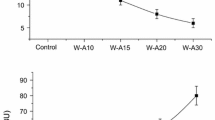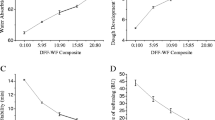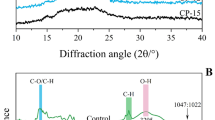Abstract
Freeze-dried okra extract was added to Hard Red Spring (HRS) wheat flour intended for high soluble-fiber bread. Seedless okra pods were blended in 0.05 M NaOH solution and the extract (OE) was freeze-dried at pH 7. SE-HPLC of OE showed the presence of covalently bound peptides. Okra extract powder (OE) 4, 7, 10, and 13 % was used to replace wheat flour in preparing four bread formulations. Although Farinograph water absorption was increased up to 4.4 % due to OE addition, the dough mixing Tolerance (MIT) was also increased. In the presence of OE, bread loaf volume was lower and freezable water was higher. Overall, bread firmness was lower at lower storage temperature, but higher OE increased firmness, due to water migration from crumb to crust. Color was darker for both crust and crumb. The bread melting temperature shifted to lower values at higher OE content as shown by Dynamic Mechanical Analysis (DMA). The test indicated that the properties of the blends were similar around the glass transition region. Dynamic rheology of the blends revealed weaker visco-elastic behavior compared to the control. The magnitude of the complex moduli for the 4 % OE was independent of frequency, while the remaining blends were frequency dependent.






Similar content being viewed by others
References
AACCI – American Association of Cereal Chemists International (2000) Approved methods of the AACCI, 10th edn. AACCI, St. Paul, Methods 10-05, 10-09, 39-06, 54-21, and 74-09
Baik MY, Chinachoti P (2003) Water self-diffusion coefficient and staling of white bread as affected by glycerol. Cer Chem 80:740–744
Barak S, Singh K (2012) Guar gum: processing, properties and food applications—A Review. J Food Sci Technol. doi:10.1007/s13197-011-0522-x
Costandino AJ, Romanchick-Cerpovicz JE (2004) Okra polysaccharides as egg white substitute. J Am Diet Assoc 104:44–48
Doi M, Edwards SF (1986) Static properties of polymers. In: Doi M, Edwards SF (eds) The theory of polymer dynamics, Chapter 2. Oxford University Press, London, pp 8–11
Ferry JD (1980) The nature of visco-elastic behavior. In: Ferry JD (ed) Viscoelastic properties of polymers, 3rd edn. John Wiley & Sons, Inc, New York, pp 1–12
Himani Kundu RBG, Goyal A, Upadhyay N, Prakash S (2012) Effect of incorporation of pumpkin (Cucurbita moshchata) powder and guar gum on the rheological properties of wheat flour. J Food Sci Technol. doi:10.1007/s13197-012-0777-x
Holas J, Tipples KH (1978) Factors affecting Farinograph and baking absorption. 1. Quality characteristics of flour stream. Cer Chem 55:637–652
Jelaca SL, Hylnka I (1971) Water binding capacity of wheat flour crude pentosans and their relation to mixing characteristics of dough. Cer Chem 48:211–222
Kang YH, Choi HC (1997) Effect of gums, fats and glutens adding on processing and quality of milled rice bread Korean. J Food Sci Technol 29:700–704
Kerch G, Rustichelli F, Ausili P, Zicans K, Meri RM, Glonin A (2008) The state of water in bread: effect of processing formulation and storage. Eur Food Res Tech 266:1469–1464
Kerch G, Zicans K, Meri RM (2010) The effect of chitosan oligosaccharides on bread staling. J Cer Sci 52:491–495
Kim SK, D’Appolonia BL (1977) Bread staling studies. III. Effects of pentosans on dough, bread, and bread staling rate. Cer Chem 54:150–160
Kobbs L (1997) Designing frozen foods. Food Prod Desi 1:27–43
Kotoki D, Deka SC (2010) Baking loss of bread with special emphasis on increasing water holding capacity. J Food Sci Technol 47:128–131
Li S, Dikinson LC, Chinachoti P (1998) Water mobility in waxy corn starch by NMR. J Ag Food Chem 46:62–71
McCleary BV (1986) Enzymatic modification of plant polysaccharides. I J Bio Macromol 8:349–354
Michmiewicz J, Biliadires CG, Bushuk W (1990) Water soluble pentosans of wheat: composition and some physical properties. Cer Chem 67:434–439
Mohamed A, Xu J, Singh M (2010) Yeast leavened banana-bread: formulation, processing, colour and texture analysis. Food Chem 118:620–626
Mohammed A, Ahmed R, Senge B (2012) Effects of chickpea flour on wheat pasting properties and bread making quality. J Food Sci Technol. doi:10.1007/s13197-012-0733-9-x
Morse DC (1998a) Viscoelasticity of tightly entangled solutions of semi-flexible polymers. Phys Rev E 58(2):1237–1240
Morse DC (1998b) Viscoelasticity of concentrated isotropic solutions of semi-flexible polymers. 1. Model and stress tensor. Macromol 31:7030–7043
Morse DC (1998c) Viscoelasticity of concentrated isotropic solutions of semi-flexible polymers. 2. Linear response. Macromol 31:7044–7067
Mudgi D, Barak S (2011) Guar gum: processing, properties, and food application—A Review. J Food Sci Technol. doi:10.1007/s13197-011-0522-x
Patel T, Brunce J, Merry A (1993) Use of hydrazine to release in intact and unreduced form both N- and O-linked oligosaccharides from glycoproteins. Biochem 32:679–693
Peleg M (1993) Mapping the stiffness-temperature-moisture relationship of solid biomaterials at and around their glass transition. Rheol Acta 32:575–580
Peleg M (1994) Mathematical characterization and graphical presentation of the stiffness-temperature-moisture relationship of gliadin. Biotech Prog 10:652–654
Ramadas U, Tharanathan RN (1987) Functional properties of okra mucilage. Starch 39(5):165–167
Romanchick-Cerpovicz JE, Tilmon RW, Baldreee K (2002) Okra polysaccharides as fat replacer in chocolate and cookies. J Am Diet Assoc 102:1301–1303
Schwrzlaff SS, Johnson JM, Barbeau WF, Duncan S (1996) Guar and locust bean gums as replacers of all-purpose four in bread: an objective and sensory evaluation. J Food Qual 19:217–229
Sengkhamparn N, Verhoef R, Schols HA, Sajjaanantakul T (2009) Characterization of cell wall polysaccharides of okra. Carbo Res 344:1824–1832
Seyhun N, Sumnu GI, Sahin S (2003) Effects of different emulsifier types, fat contents, and gum types on retardation of staling of microwave-baked cakes. Nah/Food 47(4):248–251
Sharadanant S, Khan K (2003a) Effect of hydrophilic gums on frozen dough I: dough quality. Cer Chem 80(6):764–772
Sharadanant S, Khan K (2003b) Effect of hydrophilic gums on frozen dough II: bread characteristics. Cer Chem 80(6):773–780
Shelton DR, D’Appolonia BL (1985) Carbohydrates functionality in the baking process. Cer Foods W 30:437–442
Tomada M, Shimada K, Saito Y, Sugi M (1980) Okra polysaccharides structure. Chem Pharm Bull 28:2933–2940
Vittadini E, Vodovotz Y (2003) Changes in the physicochemical properties of wheat and soy-containing breads during storage as studied by thermal analysis. J Food Sci 68(6):2022–2027
Vodovotz Y, Hallberg L, Chinachoti P (1996) Effect of aging on the thermo-mechanical properties of white bread characterized by DMA and DSC. Cer Chem 73:264–270
Ward F, Andon S (1993) The use of gums in bakery foods. Am Inst BakTech Bull 15:1–8
Willhoft MA (1971) Bread staling I. Experimental study. J Ag Food Chem 22:166–169
Xu J, Bietz JA, Felker FC, Carriere CJ, Wirtz D (2001) Rheological properties of vital wheat gluten suspensions. Cer Chem 78(2):181–185
Xu J, Bietz JA, Carriere CJ (2007) Rheological properties of wheat gliadin and glutenin suspensions. Food Chem 101(3):1025–1030
Acknowledgments
The Authors extend their appreciation to the Deanship of Scientific Research at King Saud University for funding the work through the research group project No: RGP-VPP-114)) i. The authors would like to thank Jason Adkins for his technical support and A. J. Thomas for conducting the DMA measurements
Author information
Authors and Affiliations
Corresponding author
Rights and permissions
About this article
Cite this article
Alamri, M.S. Okra-gum fortified bread: formulation and quality. J Food Sci Technol 51, 2370–2381 (2014). https://doi.org/10.1007/s13197-012-0803-z
Revised:
Accepted:
Published:
Issue Date:
DOI: https://doi.org/10.1007/s13197-012-0803-z




